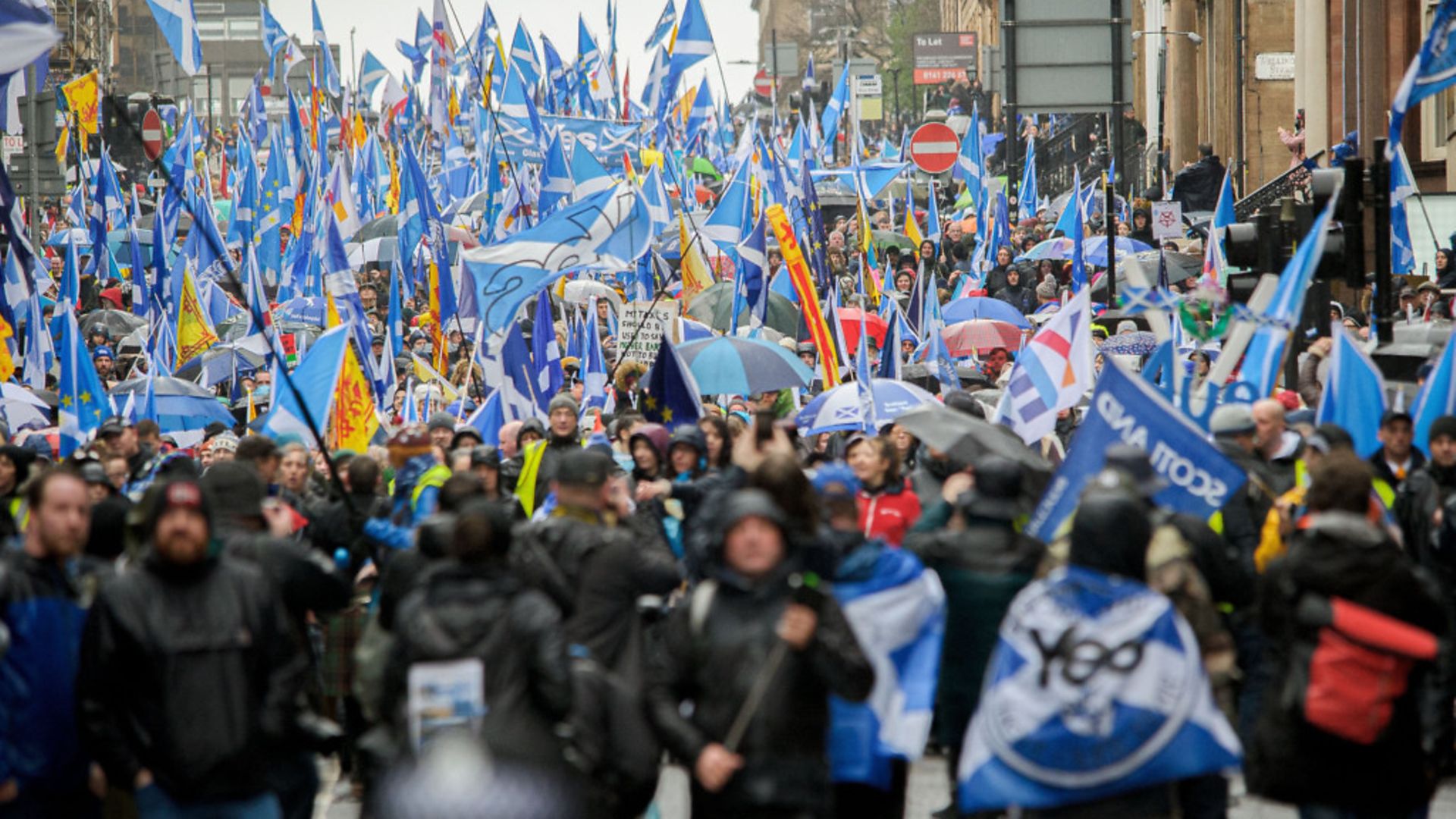
Polling expert PETER KELLNER on how the Scottish elections could supercharge the SNP’s campaign for independence.
If Boris Johnson thinks that life will get easier in the spring, he should think again. Even if the current lockdown and vaccine programme both succeed, a fresh crisis is almost certain to erupt in its wake, to last longer than coronavirus, and be harder to tackle.
This year Scottish voters will elect a new parliament to Holyrood. (Polling day should May 6 but may be delayed, along with elections in England and Wales.) Johnson has two reasons to fear the outcome. First, it is almost certain that most members of the new Holyrood parliament will want a new referendum on Scottish independence.
The second is that Scottish views on independence are now closely connected to views on Brexit. Johnson will confront not just a desire to leave the United Kingdom but a demand that Scotland rejoin the European Union. Independence is no longer an end in itself: it is now a necessary step towards a European future.
Moreover, a quirk of Scotland’s election system could result not just in a parliamentary majority in Holyrood for a new referendum, but a landslide. This would make it far harder for Johnson to continue brushing aside demands for a new vote on independence.
For some months, polls have found that most Scots want to leave the UK. For the first time a sustained majority favour independence. When we look under the bonnet at the details from the polling, it becomes clear what has happened.
At the time of the 2016 Brexit referendum, Scottish attitudes to Europe bore little relation to attitudes to Europe. Remainers and Leavers both opposed Scottish independence by similar, modest margins.
That is no longer true. Support for independence has grown sharply among pro-EU Scots, and declined by broadly the same proportion among pro-Brexit Scots. But as Remainers outnumbered Leavers in 2016 by almost two-to-one, the number of Remainers converting to independence is much larger than the number of Leavers becoming unionists. The overall effect has been a marked increase in support for independence.
Comparing YouGov’s results from just before the Brexit referendum with its latest findings from a few weeks ago shows how the ‘Brexit gap’ – the difference between Remainers and Leavers in their backing for Scottish independence – has jumped from a negligible three percentage points to as much as 30.
Separate research findings from both Ipsos MORI and the Scottish Social Attitudes Survey tell much the same story. Scottish voters are increasingly sorting themselves into two distinct tribes: those who support both independence and membership of the EU, and a smaller but still significant number who oppose both. This reconfiguration of Scottish politics has big implications for the coming election. The two pro-independence parties, the SNP and the Greens, are also strongly pro-EU. The combination of the two causes is increasingly popular.
That is not all. It is the existence of two such parties, and not just one, that could convert a majority in the electorate into a landslide in Holyrood for a fresh referendum on independence.
Scotland’s electoral system was designed to make it hard for a single party to win an outright majority. It has happened only once in the five elections that have been held: in 2011, when the SNP secured a majority of nine in the 129-member parliament. Each voter has two votes. The first is for one of the 73 local constituencies. Each of these MSPs is elected by first-past-the-post, as in a UK general election. The second vote is a regional vote. Each of Scotland’s eight regions elects seven regional MSPs, so 56 in all.
The aim is to make sure that each party’s overall number of MSPs in each region is broadly in line with each party’s regional support. This means that parties that win a significant overall vote but few if any constituency seats, win regional seats by way of compensation. By the same token, parties that win shedloads of first-past-the-post constituency seats cannot expect much joy when the regional seats are shared out.
Which is reasonably fair – unless parties and voters game the system. The point about Scotland’s system is that it is quite easy to game, and this time supporters of independence have every incentive to do so.
At the last Scottish election, the SNP won 59 of the 73 constituencies. When it came to the regional allocations, they won only four more seats. In six of the eight regions they won no regional seats at all. The latest polls indicate that SNP popularity is now higher than it was in 2016. It may well win even more constituency seats – but few, if any, regional seats.
This has a clear lesson for SNP supporters. In at least six regions, and possibly all eight, they will be wasting their regional vote if they stick with the SNP, for it could not help to elect a single extra SNP MSP. If SNP supporters want to maximise the number of pro-independence, pro-EU MSPs, they need to back another party that has the same two objectives.
This is where the existence of two such parties comes into play. The voting system provides a strong inducement for pro-independence Scots to cast their constituency vote for the SNP and their regional vote for the Greens. Suppose the SNP wins around 65 of the 73 constituencies (it could achieve this even if its current poll rating slips slightly). If the Greens’ current support holds up, they might win 8-10 regional seats without tactical voting by SNP supporters. This would bring the pro-independence total in the new parliament to 73-75, and a modest majority in Holyrood.
However, if enough voters split their vote between the SNP at the constituency level and the Greens regionally, the number of Green MSP could rise to 30 or more.
The consequences would be dramatic. Almost 100 MSPs would be pro-independence. They would outnumber the combined ranks of the anti-independence parties – the Conservatives, Labour and Liberal Democrats – by three-to-one. These pro-union parties might feel hard done by: the Greens would be gaining at their expense. But the system is what it is. As with any other voting system, there is nothing to stop voters and parties adapting their tactics to do as well as possible.
None of this means that a fresh referendum is inevitable. Legally, it would need Westminster’s consent; and Johnson has made it clear that he won’t allow it. However, that will not end the story. Whether or not the number of pro-independence MSPs is boosted in the way I describe, the election will produce a clear victory for their cause. Scottish voters are unlikely to cheer English MPs who block their way. Here is a classic example of politics colliding with the law. In the short run, the law usually has the upper hand; but in the long run, politics tends to prevail.










